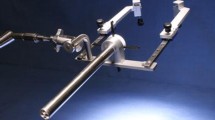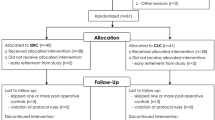Abstract
Background
Single-incision minimally invasive surgery has previously been associated with incisions 2.0–3.0 cm in length. We present a novel single-incision surgical platform compatible for insertion through a standard 15-mm trocar we previously described in six patients with short-term follow-up data. The objective of this phase II study was to evaluate the safety and feasibility of the platform in a larger collective and to evaluate 1-year follow-up data of the phase I trial.
Methods
The technology features a multiple-use introducer, accommodating the articulating instruments, and is inserted through a 15-mm laparoscopic trocar. Cholecystectomy is performed through an umbilical incision. A prospective feasibility study was performed at a single center. Inclusion criteria were age of 18–75 years and biliary colic, exclusion criteria were acute cholecystitis, dilation of the biliary tree, severe coagulopathy, BMI > 40 kg/m2, or choledocholithiasis. Endpoints included complications, length of stay, pain medication, cosmetic results, and the presence of hernia.
Results
Twenty-seven patients (23 females; phase I: 6 patients, phase II: 21 patients) with an average age of 41.7 years and BMI 26.6 kg/m2 were recruited for the study. Umbilical incision length did not exceed 15 mm. There were no intraoperative complications. Average OR time decreased from 91 min for the first six cases to 56 min for the last six cases. Average length of stay was 7.8 h. Pain control was achieved with diclofenac for no more than 7 days. All patients had no adverse events at 5-month follow-up, and all phase I patients had no adverse events nor evidence of umbilical hernia at 1 year.
Conclusion
This study demonstrates that single-incision cholecystectomy with the platform is feasible, safe, and reproducible in a larger patient population. Long-term follow-up showed no hernias or other adverse events. Further studies will be needed to evaluate longer-term hernia rates.












Similar content being viewed by others
References
Reynolds W Jr (2001) The first laparoscopic cholecystectomy. JSLS 5:89–94
Litynski GS (1996) Highlights in the history of laparoscopy. Barbara Bernert Verlag, Frankfurt, pp 165–168
Mühe E (1992) Long-term follow-up after laparoscopic cholecystectomy. Endoscopy 24:754–758
Litwin DE, Cahan MA (2008) Laparoscopic cholecystectomy. Surg Clin North Am 88:1295–1313
Keus F, de Jong JA, Gooszen HG, van Laarhoven CJ (2006) Laparoscopic versus open cholecystectomy for patients with symptomatic cholecystolithiasis. Cochrane Database Syst Rev 4:CD006231
Kim KW, Park JI, Nam SH (2013) The feasibility and safety of a three-port laparoscopic cholecystectomy using a 2 mm mini-instrument. Hepatogastroenterology 60(122):281–285
Evans SF, Petrucco OM (1998) Microlaparoscopy for suspected pelvic pathology–a comparison of 2 mm versus 10 mm laparoscope. Aust N Z J Obstet Gynaecol 38(2):215–216
Ikeda F, Abrão MS, Podgaec S, Nogueira AP, Neme RM, Pinotti JA (2001) Microlaparoscopy in gynecology: analysis of 16 cases and review of literature. Rev Hosp Clin Fac Med Sao Paulo 56(4):115–118
Nijhawan S, Barajas-Gamboa JS, Majid S, Jacobsen GR, Sedrak MF, Sandler BJ, Talamini MA, Horgan S (2013) NOTES transvaginal hybrid cholecystectomy: the United States human experience. Surg Endosc 27(2):514–517
Romanelli JR, Earle DB (2009) Single-port laparoscopic surgery: an overview. Surg Endosc 23(7):1419–1427
Gonzalez AM, Rabaza JR, Donkor C, Romero RJ, Kosanovic R, Verdeja JC (2013) Single-incision cholecystectomy: a comparative study of standard laparoscopic, robotic, and SPIDER platforms. Surg Endosc 27(12):4524–4531
Haber GP, Autorino R, Laydner H, Yang B, White MA, Hillyer S, Altunrende F, Khanna R, Spana G, Wahib I, Fareed K, Stein RJ, Kaouk JH (2012) SPIDER surgical system for urologic procedures with laparoendoscopic single-site surgery: from initial laboratory experience to first clinical application. Eur Urol 61(2):415–422
Tranchart H, Ketoff S, Lainas P, Pourcher G, Di Giuro G, Tzanis D, Ferretti S, Dautruche A, Devaquet N, Dagher I (2013) Single incision laparoscopic cholecystectomy: for what benefit? HPB (Oxford) 15(6):433–438
Allemann P, Demartines N, Schäfer M (2014) Remains of the day: biliary complications related to single-port laparoscopic cholecystectomy. World J Gastroenterol 20(3):843–851
Broderick RC, Omelanczuk P, Harnsberger CR, Fuchs HF, Berducci M, Nefa J, Nicolia J, Almadani M, Jacobsen GR, Sandler BJ, Horgan S (2015) Laparoscopic cholecystectomy using a novel single-incision surgical platform through a standard 15 mm trocar: initial experience and technical details. Surg Endosc 29(5):1250–1256
Chen KH, Chen LR, Seow KM (2015) Ovarian suspension with adjustable sutures: an easy and helpful technique for facilitating laparoendoscopic single site gynecologic surgery. J Minim Invasive Gynecol. doi:10.1016/j.jmig.2015.02.018
Wagner MJ, Kern H, Hapfelmeier A, Mehler J, Schoenberg MH (2013) Single-port cholecystectomy versus multi-port cholecystectomy: a prospective cohort study with 222 patients. World J Surg 37(5):991–998
Strasberg SM, Hertl M, Soper NJ (1995) An analysis of the problem of biliary injury during laparoscopic cholecystectomy. J Am Coll Surg 180(1):101–125
Noel P, Nedelcu M, Gagner M (2014) SPIDER® sleeve gastrectomy—a new concept in single-trocar bariatric surgery: initial experience and technical details. J Visc Surg 151(2):91–96
Christoffersen MW, Brandt E, Oehlenschläger J, Rosenberg J, Helgstrand F, Jørgensen LN, Bardram L, Bisgaard T (2015) No difference in incidence of port-site hernia and chronic pain after single-incision laparoscopic cholecystectomy versus conventional laparoscopic cholecystectomy: a nationwide prospective, matched cohort study. Surg Endosc. doi:10.1007/s00464-015-4066-4
Chang SK, Wang YL, Shen L, Iyer SG, Madhavan K (2015) A randomized controlled trial comparing post-operative pain in single-incision laparoscopic cholecystectomy versus conventional laparoscopic cholecystectomy. World J Surg 39(4):897–904
Van den Boezem PB, Velthuis S, Lourens HJ, Cuesta MA, Sietses C (2014) Single-incision and NOTES cholecystectomy, are there clinical or cosmetic advantages when compared to conventional laparoscopic cholecystectomy? A case-control study comparing single-incision, transvaginal, and conventional laparoscopic technique for cholecystectomy. World J Surg 38(1):25–32
Meillat H, Birnbaum DJ, Fara R, Mancini J, Berdah S, Bège T (2015) Do height and weight affect the feasibility of single-incision laparoscopic cholecystectomy? Surg Endosc
Overby DW, Apelgren KN, Richardson W, Fanelli R, Society of American Gastrointestinal and Endoscopic Surgeons (2010) SAGES guidelines for the clinical application of laparoscopic biliary tract surgery. Surg Endosc 24(10):2368–2386
McLemore EC, Weston LA, Coker AM, Jacobsen GR, Talamini MA, Horgan S, Ramamoorthy SL (2014) Transanal minimally invasive surgery for benign and malignant rectal neoplasia. Am J Surg 208(3):372–381
Fuchs KH, Breithaupt W, Varga G, Schulz T, Reinisch A, Josipovic N (2013) Transanal hybrid colon resection: from laparoscopy to NOTES. Surg Endosc 27(3):746–752
Sylla P, Bordeianou LG, Berger D, Han KS, Lauwers GY, Sahani DV, Sbeih MA, Lacy AM, Rattner DW (2013) A pilot study of natural orifice transanal endoscopic total mesorectal excision with laparoscopic assistance for rectal cancer. Surg Endosc 27(9):3396–3405
Acknowledgments
This study was made possible by funding support received from Fortimedix Surgical B.V. (grant).
Author information
Authors and Affiliations
Corresponding author
Ethics declarations
Disclosures
This study was made possible by funding support received from Fortimedix Surgical B.V. Dr. Pablo Omelanczuk is an investigator for Fortimedix Surgical B.V. Dr. Santiago Horgan is an investigator, maintains stock options, and is on the advisory board for Fortimedix Surgical B.V. Drs. Berducci, Fuchs, Broderick, Harnsberger, Langert, Nefa, Jaureguiberry, Gomez, Miranda, Jacobsen, and Sandler have no conflicts of interest or financial ties to disclose.
Additional information
Martin Berducci and Hans F. Fuchs have contributed equally to this manuscript.
Rights and permissions
About this article
Cite this article
Berducci, M., Fuchs, H.F., Omelanczuk, P. et al. Phase II clinical experience and long-term follow-up using the next-generation single-incision platform FMX314. Surg Endosc 30, 953–960 (2016). https://doi.org/10.1007/s00464-015-4319-2
Received:
Accepted:
Published:
Issue Date:
DOI: https://doi.org/10.1007/s00464-015-4319-2




